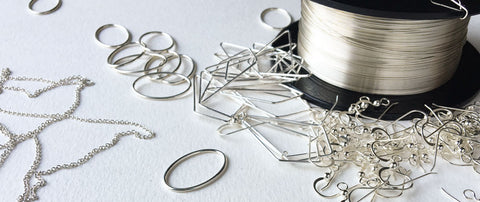
Our ongoing investigation into the environmental impact of running a business. Today, we're looking at the environmental impact of silver. Find the rest of the series here.
About 15% of a pair of earrings is silver - in the form of ear hooks and wire. And this is the thing I've been most worried about in terms of environmental impact. Over the past couple years I've been very involved trying to fight a mining proposal in Alaska: Pebble Mine. This has led me to learn all sorts of frightening things about the mining industry's track record and impact on the environment.
Mining Industry Environmental Impact
- Mining is the most polluting industry in the country ( EPA Toxics Release Inventory).
- Major threats to water include acid mine drainage, cyanide spills, and heavy metal pollution.
- Fish are especially sensitive to heavy metals in the water (more than people).
- A recent study shows that 76% of the U.S. mines surveyed exceeded water quality standards, polluting rivers and groundwater.
- According to the Environmental Protection Agency (EPA), mine waste has contaminated more than 40 percent of the headwaters of western watersheds.
Buying Better Silver?
This begs the obvious question - can we avoid contributing to these problems by buying recycled or otherwise responsibly mined silver?As far as I can tell - no. This is one of the big problems in the metal industry - there are so many middlemen, and no way for consumers to tell where the metal comes from. Hence no pressure on the mining companies to be more responsible. The numbers above are from the U.S. In third world countries, the problems are even worse.
Ethical Metalsmiths and No Dirty Gold have made some progress on demanding greener gold, and trying to pressure jewelry retailers to carry it. Gold is a bigger problem than silver, simply because gold is rarer and more precious. It is present at much lower concentrations in the ore, so more damage is done getting a given amount of gold out of the ground. But silver is subject to all the same problems - metal ores often occur together, so they actually come from many of the same mines.
Energy Use and Greenhouse Gases
This is a pretty rough calculation, involving a whole lot of metric/english unit conversions (courtesy of google). Searching for the ounces per ton of silver at different mines, and looking in the book "Golden Dreams, Poisoned Streams", I found that 25 oz/ton seemed about right (number is on the high end to try and take into account that the ton of ore contains other metals as well). Then I headed over to Canada to get the "energy intensity" of their mining industry (source link no longer available), expressed in Gigajoules per metric tonne of ore. I'll just assume Canada is representative. Then I multiplied that by how many ounces of silver you get in a ton of ore, and how many ounces are in a thousand pairs of our simplest Sundrop earrings. I don't have CO2 numbers directly, but am assuming the carbon emissions per energy unit are similar to glass and paper.
The answer is pretty rough, but shows that silver is several times more wasteful than paper or glass in straight energy terms. This is despite the fact that we use more glass and paper than we do silver. And it's not even accounting for most of mining's impacts described above - just the energy. I don't have a great solution to this. But it seems like what all users of silver need to do is start putting pressure on our suppliers - perhaps we can get a source of recycled silver.
Update January 4, 2010: We can (and do) now source recycled silver wire for all our wire wrapping.
Update July 15, 2015: Finally recycled silver ear hooks are available as well as recycled silver wire - and we're using them!






I found the article very informative, thanks! I was particularly looking for the link between gold and silver mining and ETFs which I found in the last para. I think I’ll be staying away from such ETFs at least for now.